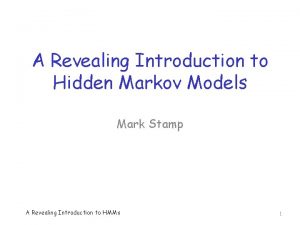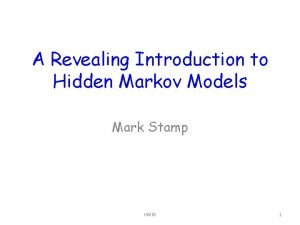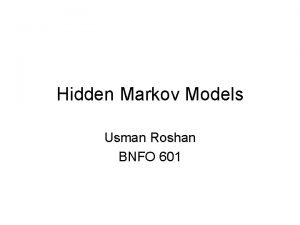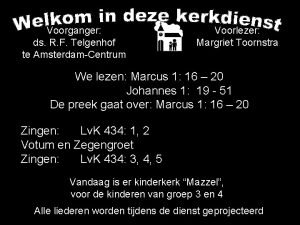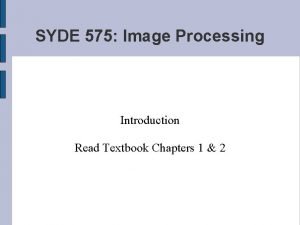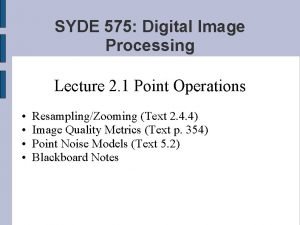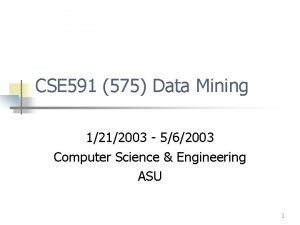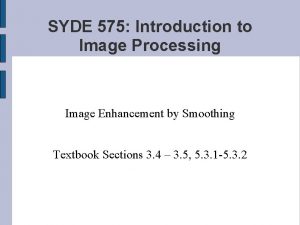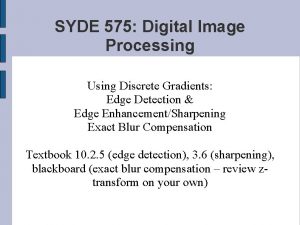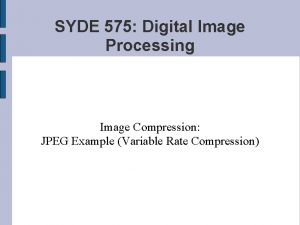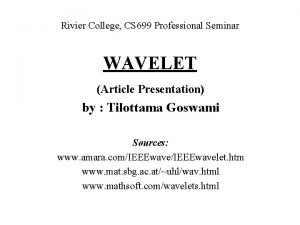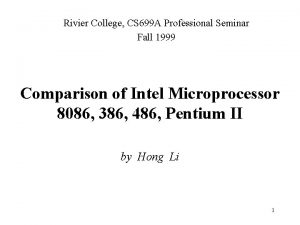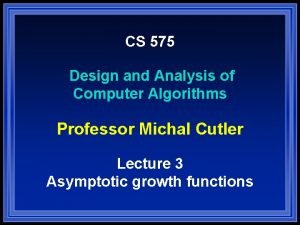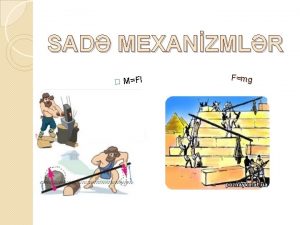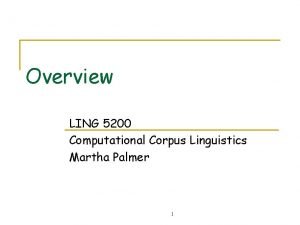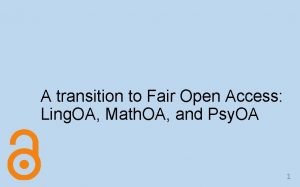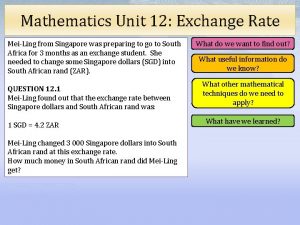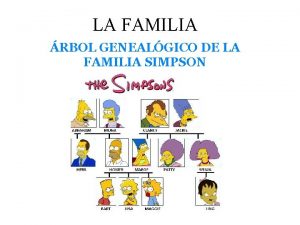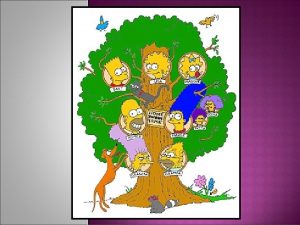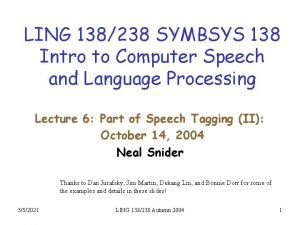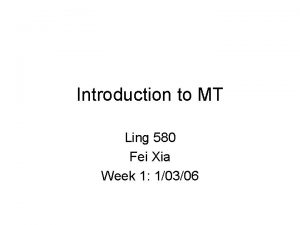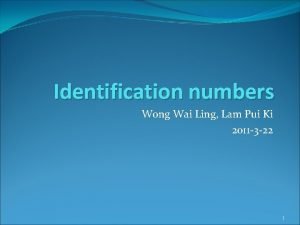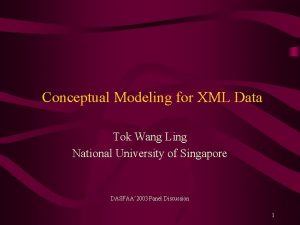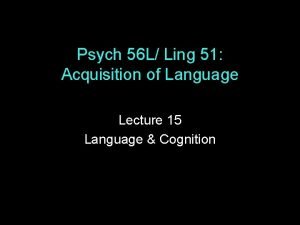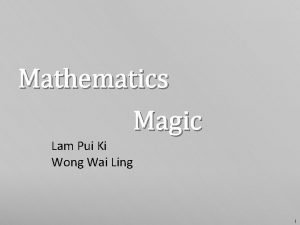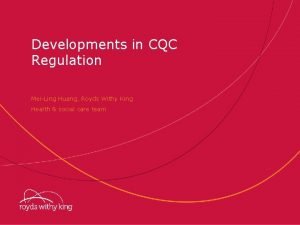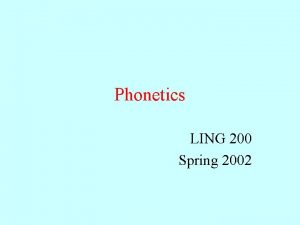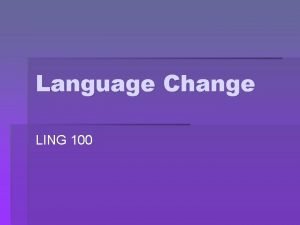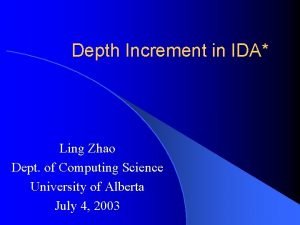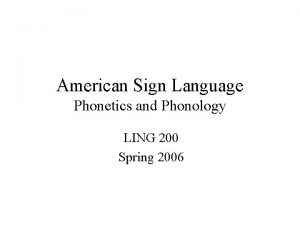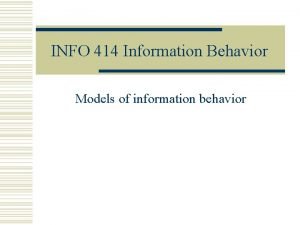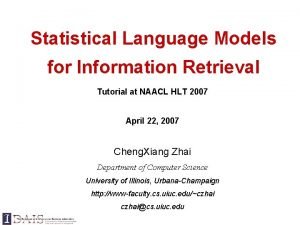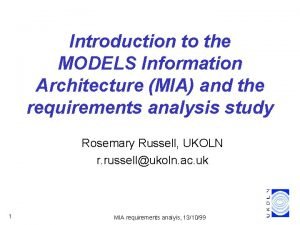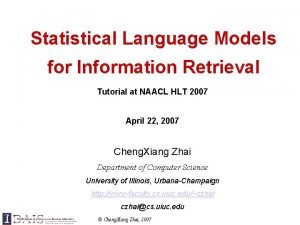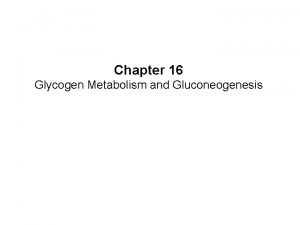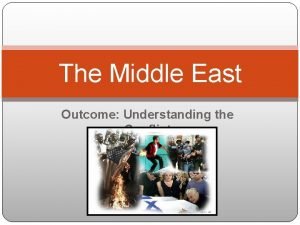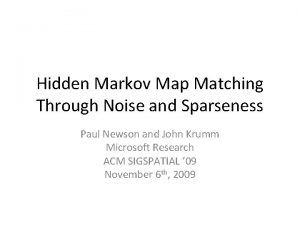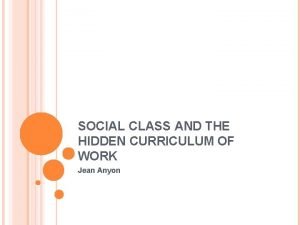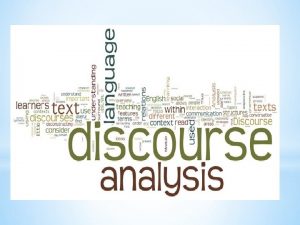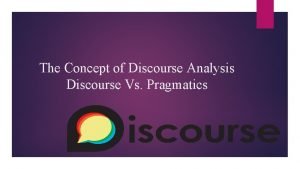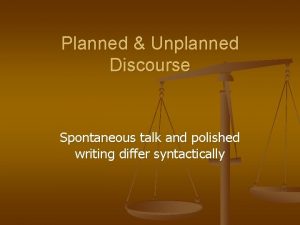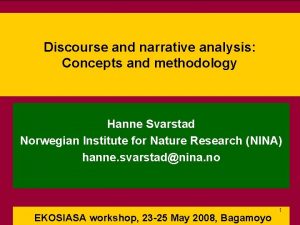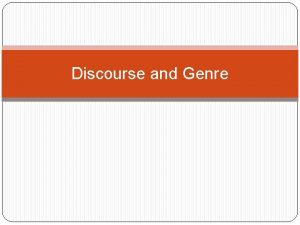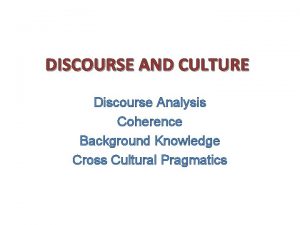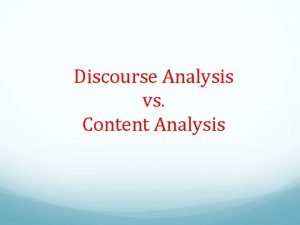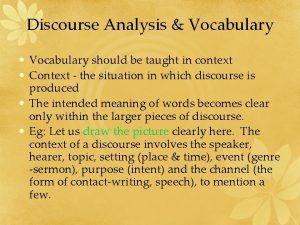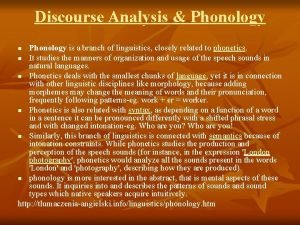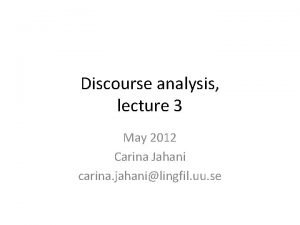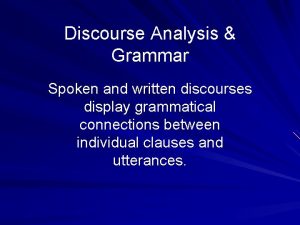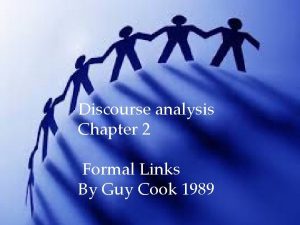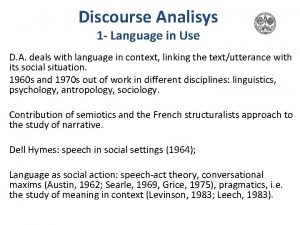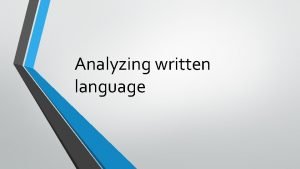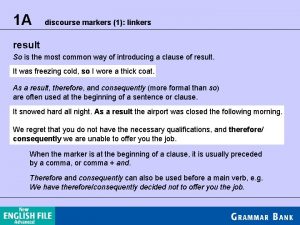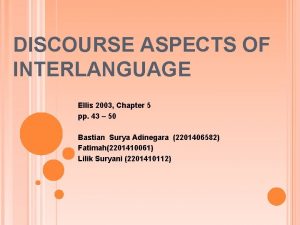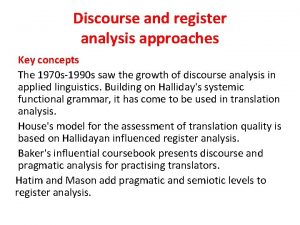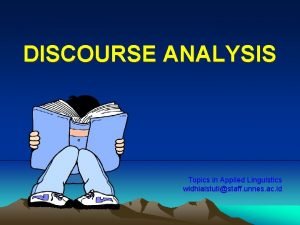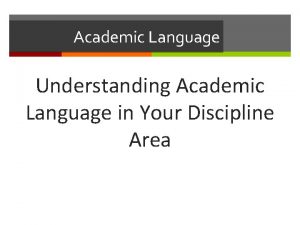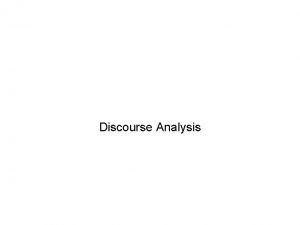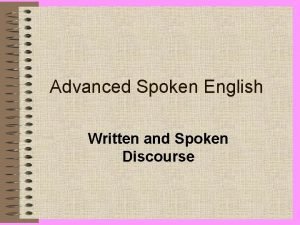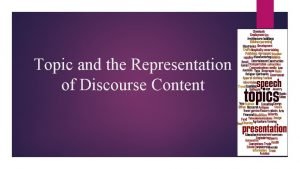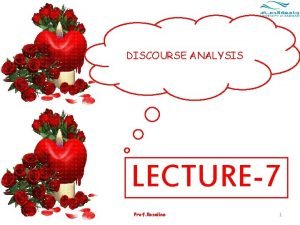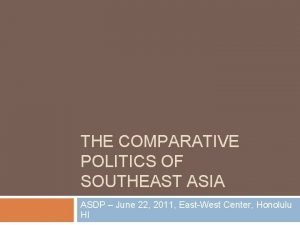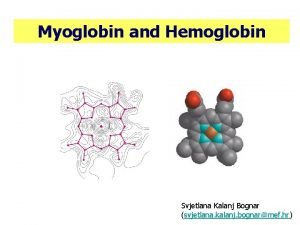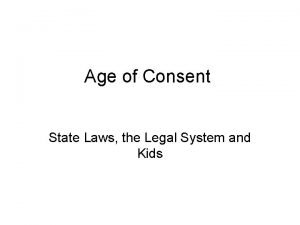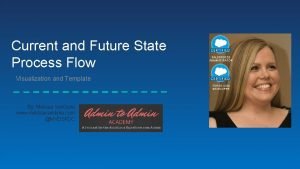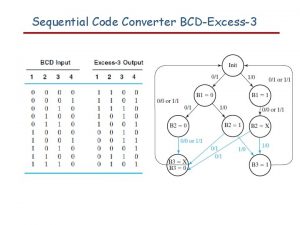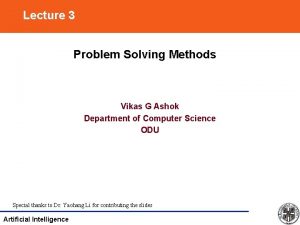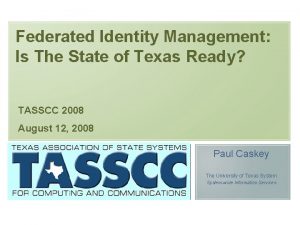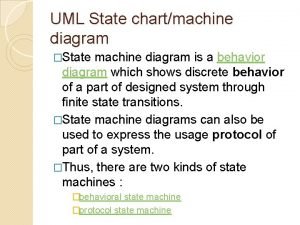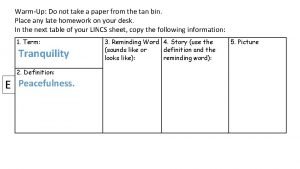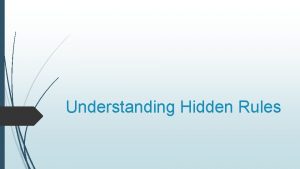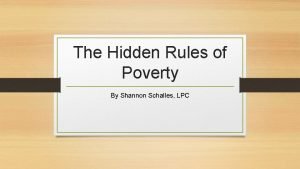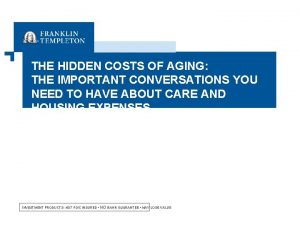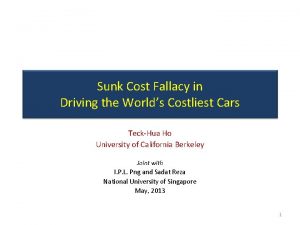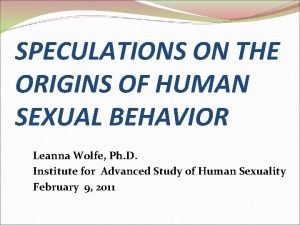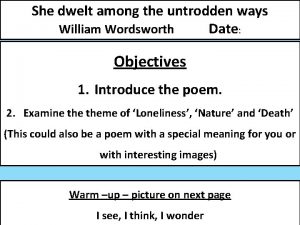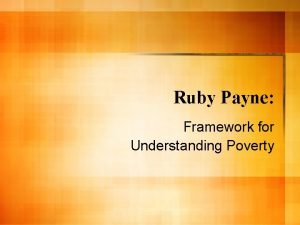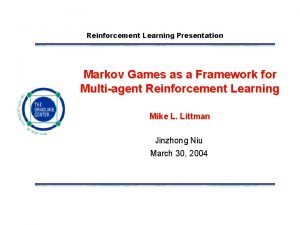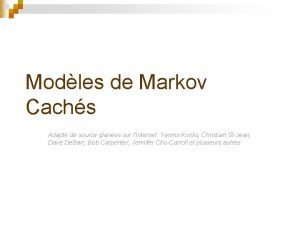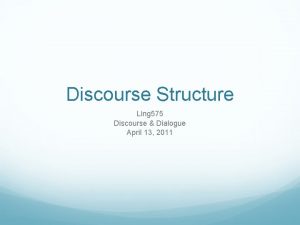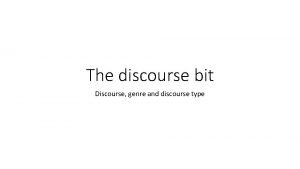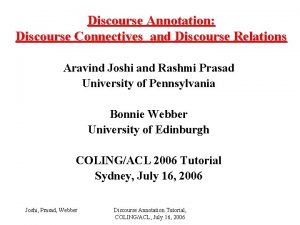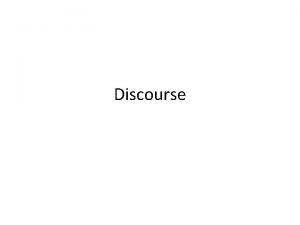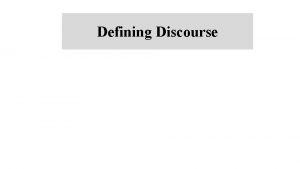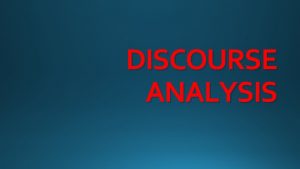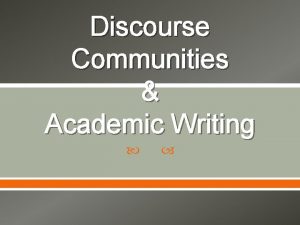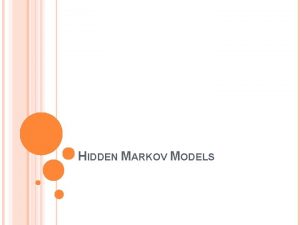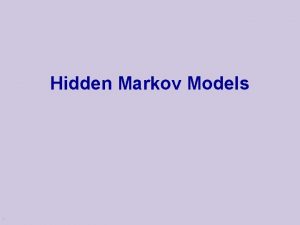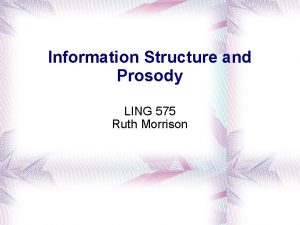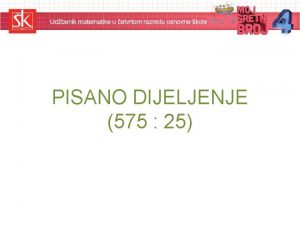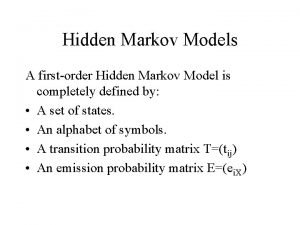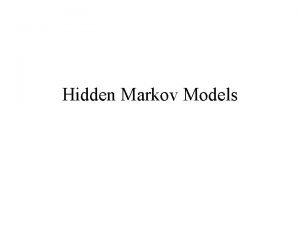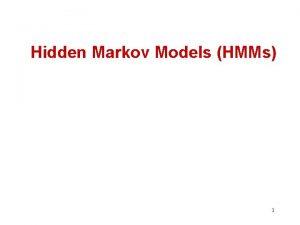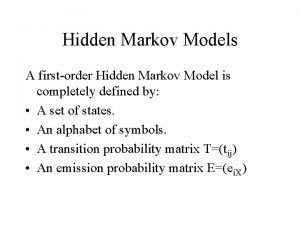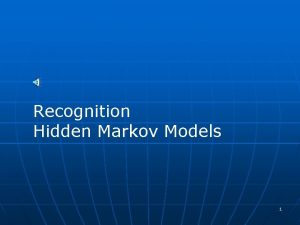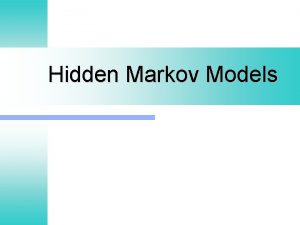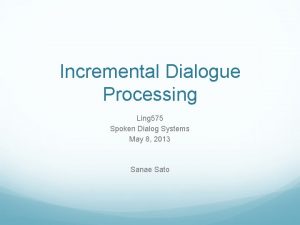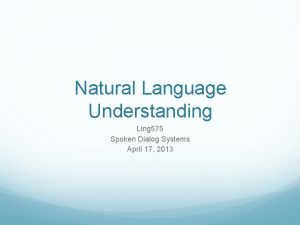Hidden Information State Models Ling 575 Discourse and


































































































































- Slides: 130

(Hidden) Information State Models Ling 575 Discourse and Dialogue May 25, 2011

Roadmap Information State Models Dialogue Act Recognition Hidden Information State Models Learning dialogue behavior Politeness and Speaking Style Generating styles

Information State Systems Information state : Discourse context, grounding state, intentions, plans. Dialogue acts: Extension of speech acts, to include grounding acts Request-inform; Confirmation Update rules Modify information state based on DAs When a question is asked, answer it When an assertion is made, Add information to context, grounding state

Information State Architecture Simple ideas, complex execution

Dialogue Acts Extension of speech acts Adds structure related to conversational phenomena Grounding, adjacency pairs, etc

Dialogue Acts Extension of speech acts Adds structure related to conversational phenomena Grounding, adjacency pairs, etc Many proposed tagsets Verbmobil: acts specific to meeting sched domain

Dialogue Acts Extension of speech acts Adds structure related to conversational phenomena Grounding, adjacency pairs, etc Many proposed tagsets Verbmobil: acts specific to meeting sched domain DAMSL: Dialogue Act Markup in Several Layers Forward looking functions: speech acts Backward looking function: grounding, answering

Dialogue Acts Extension of speech acts Adds structure related to conversational phenomena Grounding, adjacency pairs, etc Many proposed tagsets Verbmobil: acts specific to meeting sched domain DAMSL: Dialogue Act Markup in Several Layers Forward looking functions: speech acts Backward looking function: grounding, answering Conversation acts: Add turn-taking and argumentation relations

Verbmobil DA 18 high level tags

Dialogue Act Interpretation Automatically tag utterances in dialogue Some simple cases: Will breakfast be served on USAir 1557?

Dialogue Act Interpretation Automatically tag utterances in dialogue Some simple cases: YES-NO-Q: Will breakfast be served on USAir 1557? I don’t care about lunch.

Dialogue Act Interpretation Automatically tag utterances in dialogue Some simple cases: YES-NO-Q: Will breakfast be served on USAir 1557? Statement: I don’t care about lunch. Show be flights from L. A. to Orlando

Dialogue Act Interpretation Automatically tag utterances in dialogue Some simple cases: YES-NO-Q: Will breakfast be served on USAir 1557? Statement: I don’t care about lunch. Command: Show be flights from L. A. to Orlando Is it always that easy? Can you give me the flights from Atlanta to Boston?

Dialogue Act Interpretation Automatically tag utterances in dialogue Some simple cases: YES-NO-Q: Will breakfast be served on USAir 1557? Statement: I don’t care about lunch. Command: Show be flights from L. A. to Orlando Is it always that easy? Can you give me the flights from Atlanta to Boston? Syntactic form: question; Act: request/command Yeah.

Dialogue Act Interpretation Automatically tag utterances in dialogue Some simple cases: YES-NO-Q: Will breakfast be served on USAir 1557? Statement: I don’t care about lunch. Command: Show be flights from L. A. to Orlando Is it always that easy? Can you give me the flights from Atlanta to Boston? Yeah. Depends on context: Y/N answer; agreement; back-channel

Dialogue Act Ambiguity Indirect speech acts

Dialogue Act Ambiguity Indirect speech acts

Dialogue Act Ambiguity Indirect speech acts

Dialogue Act Ambiguity Indirect speech acts

Dialogue Act Ambiguity Indirect speech acts

Dialogue Act Recognition How can we classify dialogue acts? Sources of information:

Dialogue Act Recognition How can we classify dialogue acts? Sources of information: Word information: Please, would you: request; are you: yes-no question

Dialogue Act Recognition How can we classify dialogue acts? Sources of information: Word information: Please, would you: request; are you: yes-no question N-grammars Prosody:

Dialogue Act Recognition How can we classify dialogue acts? Sources of information: Word information: Please, would you: request; are you: yes-no question N-grammars Prosody: Final rising pitch: question; final lowering: statement Reduced intensity: Yeah: agreement vs backchannel

Dialogue Act Recognition How can we classify dialogue acts? Sources of information: Word information: Please, would you: request; are you: yes-no question N-grammars Prosody: Final rising pitch: question; final lowering: statement Reduced intensity: Yeah: agreement vs backchannel Adjacency pairs:

Dialogue Act Recognition How can we classify dialogue acts? Sources of information: Word information: Please, would you: request; are you: yes-no question N-grammars Prosody: Final rising pitch: question; final lowering: statement Reduced intensity: Yeah: agreement vs backchannel Adjacency pairs: Y/N question, agreement vs Y/N question, backchannel DA bi-grams

Task & Corpus Goal: Identify dialogue acts in conversational speech

Task & Corpus Goal: Identify dialogue acts in conversational speech Spoken corpus: Switchboard Telephone conversations between strangers Not task oriented; topics suggested 1000 s of conversations recorded, transcribed, segmented

Dialogue Act Tagset Cover general conversational dialogue acts No particular task/domain constraints

Dialogue Act Tagset Cover general conversational dialogue acts No particular task/domain constraints Original set: ~50 tags Augmented with flags for task, conv mgmt 220 tags in labeling: some rare

Dialogue Act Tagset Cover general conversational dialogue acts No particular task/domain constraints Original set: ~50 tags Augmented with flags for task, conv mgmt 220 tags in labeling: some rare Final set: 42 tags, mutually exclusive SWBD-DAMSL Agreement: K=0. 80 (high)

Dialogue Act Tagset Cover general conversational dialogue acts No particular task/domain constraints Original set: ~50 tags Augmented with flags for task, conv mgmt 220 tags in labeling: some rare Final set: 42 tags, mutually exclusive SWBD-DAMSL Agreement: K=0. 80 (high) 1, 155 conv labeled: split into train/test

Common Tags Statement & Opinion: declarative +/- op Question: Yes/No&Declarative: form, force Backchannel: Continuers like uh-huh, yeah Turn Exit/Adandon: break off, +/- pass Answer : Yes/No, follow questions Agreement: Accept/Reject/Maybe

Probabilistic Dialogue Models HMM dialogue models

Probabilistic Dialogue Models HMM dialogue models States = Dialogue acts; Observations: Utterances Assume decomposable by utterance Evidence from true words, ASR words, prosody

Probabilistic Dialogue Models HMM dialogue models States = Dialogue acts; Observations: Utterances Assume decomposable by utterance Evidence from true words, ASR words, prosody

Probabilistic Dialogue Models HMM dialogue models States = Dialogue acts; Observations: Utterances Assume decomposable by utterance Evidence from true words, ASR words, prosody

Probabilistic Dialogue Models HMM dialogue models States = Dialogue acts; Observations: Utterances Assume decomposable by utterance Evidence from true words, ASR words, prosody

DA Classification - Prosody Features: Duration, pause, pitch, energy, rate, gender Pitch accent, tone Results: Decision trees: 5 common classes 45. 4% - baseline=16. 6%

Prosodic Decision Tree

DA Classification -Words Combines notion of discourse markers and collocations: e. g. uh-huh=Backchannel Contrast: true words, ASR 1 -best, ASR n-best Results: Best: 71%- true words, 65% ASR 1 -best

DA Classification - All Combine word and prosodic information Consider case with ASR words and acoustics

DA Classification - All Combine word and prosodic information Consider case with ASR words and acoustics Prosody classified by decision trees Incorporate decision tree posteriors in model for P(f|d)

DA Classification - All Combine word and prosodic information Consider case with ASR words and acoustics Prosody classified by decision trees Incorporate decision tree posteriors in model for P(f|d) Slightly better than raw ASR

Integrated Classification Focused analysis Prosodically disambiguated classes Statement/Question-Y/N and Agreement/Backchannel Prosodic decision trees for agreement vs backchannel Disambiguated by duration and loudness

Integrated Classification Focused analysis Prosodically disambiguated classes Statement/Question-Y/N and Agreement/Backchannel Prosodic decision trees for agreement vs backchannel Disambiguated by duration and loudness Substantial improvement for prosody+words True words: S/Q: 85. 9%-> 87. 6; A/B: 81. 0%->84. 7

Integrated Classification Focused analysis Prosodically disambiguated classes Statement/Question-Y/N and Agreement/Backchannel Prosodic decision trees for agreement vs backchannel Disambiguated by duration and loudness Substantial improvement for prosody+words True words: S/Q: 85. 9%-> 87. 6; A/B: 81. 0%->84. 7 ASR words: S/Q: 75. 4%->79. 8; A/B: 78. 2%->81. 7 More useful when recognition is iffy

Many Variants Maptask: (13 classes) Serafin & Di. Eugenio 2004 Latent Semantic analysis on utterance vectors Text only Game information; No improvement for DA history

Many Variants Maptask: (13 classes) Serafin & Di. Eugenio 2004 Latent Semantic analysis on utterance vectors Text only Game information; No improvement for DA history Surendran & Levow 2006 SVMs on term n-grams, prosody Posteriors incorporated in HMMs Prosody, sequence modeling improves

Many Variants Maptask: (13 classes) Serafin & Di. Eugenio 2004 Latent Semantic analysis on utterance vectors Text only Game information; No improvement for DA history Surendran & Levow 2006 SVMs on term n-grams, prosody Posteriors incorporated in HMMs Prosody, sequence modeling improves MRDA: Meeting tagging: 5 broad classes

Observations DA classification can work on open domain Exploits word model, DA context, prosody Best results for prosody+words Words are quite effective alone – even ASR Questions:

Observations DA classification can work on open domain Exploits word model, DA context, prosody Best results for prosody+words Words are quite effective alone – even ASR Questions: Whole utterance models? – more fine-grained Longer structure, long term features

Detecting Correction Acts Miscommunication is common in SDS Utterances after errors misrecognized >2 x as often Frequently repetition or paraphrase of original input

Detecting Correction Acts Miscommunication is common in SDS Utterances after errors misrecognized >2 x as often Frequently repetition or paraphrase of original input Systems need to detect, correct

Detecting Correction Acts Miscommunication is common in SDS Utterances after errors misrecognized >2 x as often Frequently repetition or paraphrase of original input Systems need to detect, correct Corrections are spoken differently: Hyperarticulated (slower, clearer) -> lower ASR conf.

Detecting Correction Acts Miscommunication is common in SDS Utterances after errors misrecognized >2 x as often Frequently repetition or paraphrase of original input Systems need to detect, correct Corrections are spoken differently: Hyperarticulated (slower, clearer) -> lower ASR conf. Some word cues: ‘No’, ’ I meant’, swearing. .

Detecting Correction Acts Miscommunication is common in SDS Utterances after errors misrecognized >2 x as often Frequently repetition or paraphrase of original input Systems need to detect, correct Corrections are spoken differently: Hyperarticulated (slower, clearer) -> lower ASR conf. Some word cues: ‘No’, ’ I meant’, swearing. . Can train classifiers to recognize with good acc.

Generating Dialogue Acts Generation neglected relative to generation

Generating Dialogue Acts Generation neglected relative to generation Stent (2002) model: Conversation acts, Belief model Develops update rules for content planning, e. g. If user releases turn, system can do ‘TAKE-TURN’ act If system needs to summarize, use ASSERT act

Generating Dialogue Acts Generation neglected relative to generation Stent (2002) model: Conversation acts, Belief model Develops update rules for content planning, i. e. If user releases turn, system can do ‘TAKE-TURN’ act If system needs to summarize, use ASSERT act Identifies turn-taking as key aspect of dialogue gen.

Generating Confirmation Simple systems use fixed confirmation strategy Implicit or explicit

Generating Confirmation Simple systems use fixed confirmation strategy Implicit or explicit More complex systems can select dynamically Use information state and features to decide

Generating Confirmation Simple systems use fixed confirmation strategy Implicit or explicit More complex systems can select dynamically Use information state and features to decide Likelihood of error: Low ASR confidence score If very low, can reject

Generating Confirmation Simple systems use fixed confirmation strategy Implicit or explicit More complex systems can select dynamically Use information state and features to decide Likelihood of error: Low ASR confidence score If very low, can reject Sentence/prosodic features: longer, initial pause, pitch range

Generating Confirmation Simple systems use fixed confirmation strategy Implicit or explicit More complex systems can select dynamically Use information state and features to decide Likelihood of error: Low ASR confidence score If very low, can reject Sentence/prosodic features: longer, initial pause, pitch range Cost of error:

Generating Confirmation Simple systems use fixed confirmation strategy Implicit or explicit More complex systems can select dynamically Use information state and features to decide Likelihood of error: Low ASR confidence score If very low, can reject Sentence/prosodic features: longer, initial pause, pitch range Cost of error: Book a flight vs looking up information Markov Decision Process models more detailed

Statistical Dialogue Management Pioneered by Steve Young’s group at Cambridge Model dialogue as probabilistic agent Markov Decision Process (MDP)

Statistical Dialogue Management Pioneered by Steve Young’s group at Cambridge Model dialogue as probabilistic agent Markov Decision Process (MDP) Characterized by: S: set of states agent can be in A: set of actions the agent can take R(a, s): reward agent gets for action a in state s

Statistical Dialogue Management Pioneered by Steve Young’s group at Cambridge Model dialogue as probabilistic agent Markov Decision Process (MDP) Characterized by: S: set of states agent can be in A: set of actions the agent can take R(a, s): reward agent gets for action a in state s Learn: Π: Policy: Which action a should agent in state s take to achieve highest reward?

Dialogue States Encapsulate information about current dialogue History: Everything (all states) so far?

Dialogue States Encapsulate information about current dialogue History: Everything (all states) so far? Explosive

Dialogue States Encapsulate information about current dialogue History: Everything (all states) so far? Explosive Markov assumptions Typically: Value of current frame slots, Most recent system question Most recent user answer, ASR confidence, etc

Dialogue States Encapsulate information about current dialogue History: Everything (all states) so far? Explosive Markov assumptions Typically: Value of current frame slots, Most recent system question Most recent user answer, ASR confidence, etc For day, month frame: 411 states!

Actions & Rewards For day, month input:

Actions & Rewards For day, month input: A 1: question asking for day

Actions & Rewards For day, month input: A 1: question asking for day A 2: question asking for month A 3: question asking for day and month A 4: submitting the form

Actions & Rewards For day, month input: A 1: question asking for day A 2: question asking for month A 3: question asking for day and month A 4: submitting the form Reward: Correct answer with shortest interaction R = (wini+wcnc+wfnf) Ni: # interactions; nc: # errors; nf: # filled slots

Policies 1) Asking for Day, Month together 2) Asking for Day, Month separately Compute reward for each policy, given some P(error)

Utility A utility function maps a state or state sequence onto a real number describing the goodness of that state I. e. the resulting “happiness” of the agent Speech and Language Processing -- Jurafsky and Martin

Utility A utility function maps a state or state sequence onto a real number describing the goodness of that state I. e. the resulting “happiness” of the agent Principle of Maximum Expected Utility: A rational agent should choose an action that maximizes the agent’s expected utility Speech and Language Processing -- Jurafsky and Martin

Learning Policies Simple system: Can enumerate policies and select

Learning Policies Simple system: Can enumerate policies and select Complex system:

Learning Policies Simple system: Can enumerate policies and select Complex system: Huge number of actions, states, policies Selection is complex optimization problem Can describe expected cumulative reward w/Bellman eqn Standard approach in reinforcement learning Solvable with value iteration algorithm

Training the Model State transition probabilities must be estimated For small corpus

Training the Model State transition probabilities must be estimated For small corpus Get real users for system Compute results for different choices (i. e. initiative) Directly collect empirical estimate For larger system,

Training the Model State transition probabilities must be estimated For small corpus Get real users for system Compute results for different choices (i. e. initiative) Directly collect empirical estimate For larger system, too many alternatives Need arbitrary number of users

Training the Model State transition probabilities must be estimated For small corpus Get real users for system Compute results for different choices (i. e. initiative) Directly collect empirical estimate For larger system, too many alternatives Need arbitrary number of users Simulation!! Stochastic state selection

Training the Model State transition probabilities must be estimated For small corpus Get real users for system Compute results for different choices (i. e. initiative) Directly collect empirical estimate For larger system, too many alternatives Need arbitrary number of users Simulation!! Stochastic state selection Learned policies can outperform hand-crafted

Politeness & Speaking Style

Agenda Motivation Explaining politeness & indirectness Face & rational reasoning Defusing Face Threatening Acts Selecting & implementing speaking styles Plan-based speech act modeling Socially appropriate speaking styles

Why be Polite to Computers? Computers don’t have feelings, status, etc Would people be polite to a machine?

Why be Polite to Computers? Computers don’t have feelings, status, etc Would people be polite to a machine? Range of politeness levels: Direct < Hinting < Conventional Indirectness Why?

Varying Politeness Direct Requests:

Varying Politeness Direct Requests: Read it to me Go to the next group Next message Polite Requests: Conventional Indirectness

Varying Politeness Direct Requests: Read it to me Go to the next group Next message Polite Requests: Conventional Indirectness I’d like to check Nicole’s calendar Could I have the short term forecast for Boston? Weather please Goodbye spirals

Why are People Polite to Each Other?

Why are People Polite to Each Other? “Convention” Begs the question - why become convention? Indirectness

Why are People Polite to Each Other? “Convention” Begs the question - why become convention? Indirectness Not just adding as many hedges as possible “Could someone maybe please possibly be able to. . ”

Why are People Polite to Each Other? “Convention” Begs the question - why become convention? Indirectness Not just adding as many hedges as possible “Could someone maybe please possibly be able to. . ” Social relation and rational agency Maintaining face, rational reasoning Pragmatic clarity

Face Kernel of politeness Cross-cultural Public self-image

Face Kernel of politeness Cross-cultural Public self-image Negative: Claim of freedom to action, from imposition “Want” to be unimpeded by others: “Autonomy”

Face Kernel of politeness Cross-cultural Public self-image Negative: Claim of freedom to action, from imposition “Want” to be unimpeded by others: “Autonomy” Positive: Desire to be approved of “Want” to be liked - usually by specific people for specific attr Generally cooperate to preserve face Mutually vulnerable

Threatening & Saving Face Communicative acts may threaten face Negative:

Threatening & Saving Face Communicative acts may threaten face Negative: Put pressure on H to do, accept E. g. request, suggest, remind, offer, compliment, . . Positive

Threatening & Saving Face Communicative acts may threaten face Negative: Put pressure on H to do, accept E. g. request, suggest, remind, offer, compliment, . . Positive: Indicate dislike or indifference to face E. g. criticism, disapproval, contradiction, boasting Threats to H’s or S’s face; positive/negative

Threatening & Saving Face Communicative acts may threaten face Negative: Put pressure on H to do, accept E. g. request, suggest, remind, offer, compliment, . . Positive: Indicate dislike or indifference to face E. g. criticism, disapproval, contradiction, boasting Threats to H’s or S’s face; positive/negative Given threats, rational agents will minimize Constraints: communicate content, be efficient, maintain H’s face

How to be Polite On-record: with clear intent

How to be Polite On-record: with clear intent Without redress, baldly: Direct: clear and concise as possible Very casual or very urgent

How to be Polite On-record: with clear intent Without redress, baldly: Direct: clear and concise as possible Very casual or very urgent With redress, positive: Indicate S want H’s wants

How to be Polite On-record: with clear intent Without redress, baldly: Direct: clear and concise as possible Very casual or very urgent With redress, positive: Indicate S want H’s wants With redress, negative: avoidance-based Conventional indirectness

How to be Polite On-record: with clear intent Without redress, baldly: Direct: clear and concise as possible Very casual or very urgent With redress, positive: Indicate S want H’s wants With redress, negative: avoidance-based Conventional indirectness Off-record: ambiguous intent - hint Don’t ask….

Indirectness vs Politeness not just maximal indirectness Not just maintain face Balance minimizing inferential effort If too indirect, inferential effort high E. g. hinting viewed as impolite Conventionalized indirectness eases interp Maintain face and pragmatic clarity

Generating Speaking Styles Stylistic choices Semantic content, syntactic form, acoustic realiz’n Lead listeners to make inferences about character and personality Base on: Speech Acts Social Interaction & Linguistic Style

Dialogue Act Modeling Small set of basic communicative intents Initiating: Inform, offer, request-info, request-act Response: Accept or reject: offer, request, act

Dialogue Act Modeling Small set of basic communicative intents Initiating: Inform, offer, request-info, request-act Response: Accept or reject: offer, request, act Distinguish: intention of act from realization Abstract representation for utterances Each utterance instantiates plan operator

Dialogue Act Model Plan-based speech act decomposition Speech Act defined as plan Header: request-act(s, h, a) Precondition: want(s, a), cando(h, a) Effects: want(h, a), know(h, want(s, a)) Decompositions Different alternatives specify surface realization Select based on social information

Decomposition & Realization Surface-request(s, h, a) “Do a”.

Decomposition & Realization Surface-request(s, h, a) “Do a”. Surface-request(s, h, informif(h, s, cando(h, a))) “Can you do a? ”

Decomposition & Realization Surface-request(s, h, a) “Do a”. Surface-request(s, h, informif(h, s, cando(h, a))) “Can you do a? ” Surface-request(s, h, ~cando(s, a)) “I can’t do a” Surface-request(s, h, want(s, a)) “I want you to do a. ”

Representing the Script (Manually) Model sequence in story/task Sequence of dialogue acts and physical acts Model world, domain plans Preconditions, effects, decompositions => semantic content Represent as input to linguistic realizer

Modeling Social Interaction Based on B&L model of speakers Face: Autonomy and Approval; Rational meaning

Modeling Social Interaction Based on B&L model of speakers Face: Autonomy and Approval; Rational meaning Based strategy on socially determined vars Social distance, Power, Ranking of Imposition: 1 -50 Requests, offer, inform: threat to auto; rejects: threat to approval

Modeling Social Interaction Based on B&L model of speakers Face: Autonomy and Approval; Rational meaning Based strategy on socially determined vars Social distance, Power, Ranking of Imposition: 1 -50 Requests, offer, inform: threat to auto; rejects: threat to approval Try to avoid threats to face Theta= social distance + power + imposition Select strategies based on theta: Direct < Approval-oriented < Autonomy-oriented<off-rec

Modeling Social Interaction Based on B&L model of speakers Face: Autonomy and Approval; Rational meaning Based strategy on socially determined vars Social distance, Power, Ranking of Imposition: 1 -50 Requests, offer, inform: threat to auto; rejects: threat to approval Try to avoid threats to face Theta= social distance + power + imposition Select strategies based on theta: Direct < Approval-oriented < Autonomy-oriented<off-rec Semantic content: plan rep; syntactic form: library

Modeling Social Interaction Based on B&L model of speakers Face: Autonomy and Approval; Rational meaning Based strategy on socially determined vars Social distance, Power, Ranking of Imposition: 1 -50 Requests, offer, inform: threat to auto; rejects: threat to approval Try to avoid threats to face Theta= social distance + power + imposition Select strategies based on theta: Direct < Approval-oriented < Autonomy-oriented<off-rec Semantic content: plan rep; syntactic form: library Affect: set acoustic realization Angry, pleasant, disgusted, annoyed, distraught, sad, gruff

Generating Appropriate Style Input: Sequence of speech acts Social status: social distance, power, ranking Emotional stance (view as orthogonal)

Generating Appropriate Style Input: Sequence of speech acts Social status: social distance, power, ranking Emotional stance (view as orthogonal) Example: Speech act= request; Status: D+P+R < 50 Direct: Imperative form: “Bring us two drinks”

Generating Appropriate Style Input: Sequence of speech acts Social status: social distance, power, ranking Emotional stance (view as orthogonal) Example: Speech act= request; Status: D+P+R < 50 Direct: Imperative form: “Bring us two drinks” Status: 91<D+P+R<120 Autonomy-oriented: query-capability-autonomy “Can you bring us two drinks? ” - Conventional indirect

Controlling Affect editor (Cahn 1990) Input: POS, phrase boundaries, focus Acoustic parameters: Vary from neutral 17: pitch, timing, voice and phoneme quality Prior evaluation: Naïve listeners reliably assign to affect class

Summary Politeness and speaking style Rational agent maintaining face, clarity Indirect requests allow hearer to save face Must be clear enough to interpret Sensitive to power and social relationships Generate appropriate style based on Dialogue acts (domain-specific plans) Define social distance and power Emotional state
 What is discourse analysis
What is discourse analysis A revealing introduction to hidden markov models
A revealing introduction to hidden markov models A revealing introduction to hidden markov models
A revealing introduction to hidden markov models Hidden markov models
Hidden markov models What is the difference between models and semi models
What is the difference between models and semi models Game theory pure strategy
Game theory pure strategy Opwekking 737
Opwekking 737 Syde 575
Syde 575 Syde 575
Syde 575 3 cestos contienen 575 manzanas el primer cesto
3 cestos contienen 575 manzanas el primer cesto Me 575
Me 575 866-575-2540
866-575-2540 Münchener verein 571+575
Münchener verein 571+575 Magni 599
Magni 599 Nbr 15 575
Nbr 15 575 Long reach ethernet
Long reach ethernet Asu cse 575
Asu cse 575 575 madison avenue
575 madison avenue Syde 575
Syde 575 Syde 575
Syde 575 Quantization matrix
Quantization matrix Enee 575
Enee 575 Intel college
Intel college Formulario 575/b
Formulario 575/b Cs 575
Cs 575 Philmont duty roster
Philmont duty roster Jin ling cigarettes
Jin ling cigarettes Mail müstəvi
Mail müstəvi Ling
Ling Erin ling
Erin ling Ling oa
Ling oa Mei-ling from singapore was preparing
Mei-ling from singapore was preparing Madre de bart lisa y maggie
Madre de bart lisa y maggie Dr ng li ling
Dr ng li ling Nien-ling wacker
Nien-ling wacker Ling shih fu
Ling shih fu Ling simpson
Ling simpson Ling adder
Ling adder History of physical education in sweden
History of physical education in sweden Walter ling
Walter ling Ling
Ling Ling138
Ling138 Ling
Ling Mtling
Mtling Lam wai ling
Lam wai ling Ling oa
Ling oa Wang ling relationship
Wang ling relationship Huo lingyu
Huo lingyu Ling rolled
Ling rolled Heart
Heart Language
Language Cheung yin ling
Cheung yin ling Magic lam
Magic lam Vocal cord
Vocal cord Long-term goals examples
Long-term goals examples Mei-ling huang
Mei-ling huang Ling 200
Ling 200 Ling internet
Ling internet Agnes ling
Agnes ling Ling 100
Ling 100 Ida ling
Ida ling Sign language phonetics
Sign language phonetics Information behavior models
Information behavior models Statistical language models for information retrieval
Statistical language models for information retrieval M.i.a.
M.i.a. Statistical language models for information retrieval
Statistical language models for information retrieval Testability tips in state graphs
Testability tips in state graphs Absorptive state and postabsorptive state
Absorptive state and postabsorptive state Glycolysis gluconeogenesis glycogenolysis glycogenesis
Glycolysis gluconeogenesis glycogenolysis glycogenesis State graphs in software testing
State graphs in software testing Entrance hidden by bricks and rubble
Entrance hidden by bricks and rubble Hidden markov map matching through noise and sparseness
Hidden markov map matching through noise and sparseness From social class and the hidden curriculum of work
From social class and the hidden curriculum of work Kinds of discourse
Kinds of discourse Discourse and socially situated identities
Discourse and socially situated identities Pragmatics in discourse analysis
Pragmatics in discourse analysis Discourse ideology
Discourse ideology Planned and unplanned discourse
Planned and unplanned discourse What is discourse analysis
What is discourse analysis What is genre
What is genre Background knowledge context
Background knowledge context Difference between content and discourse analysis
Difference between content and discourse analysis Vocabulary in discourse
Vocabulary in discourse Discourse analysis and phonology
Discourse analysis and phonology Foregrounding and backgrounding in discourse analysis
Foregrounding and backgrounding in discourse analysis Written and spoken discourse
Written and spoken discourse Formal links in discourse analysis
Formal links in discourse analysis Field tenor mode examples
Field tenor mode examples Discourse and text
Discourse and text Discourse markers reason
Discourse markers reason Discourse aspects of interlanguage
Discourse aspects of interlanguage Mode of discourse in register
Mode of discourse in register Discourse analysis topics
Discourse analysis topics Discourse analysis and vocabulary
Discourse analysis and vocabulary Discourse and syntax
Discourse and syntax Schema and script in discourse analysis
Schema and script in discourse analysis Written and spoken discourse
Written and spoken discourse Textual aspects of lexical competence
Textual aspects of lexical competence Topic and the representation of discourse content
Topic and the representation of discourse content Discourse and genre
Discourse and genre Schema and script in discourse analysis
Schema and script in discourse analysis What are the 3 properties of a liquid
What are the 3 properties of a liquid State to state regionalism
State to state regionalism Synchronous counter
Synchronous counter Svjetlana kalanj bognar
Svjetlana kalanj bognar What is the difference between an orbital and a shell
What is the difference between an orbital and a shell T state vs r state
T state vs r state Age of consent per state
Age of consent per state Current state vs future state slide
Current state vs future state slide Equivalent state
Equivalent state Duncker diagram
Duncker diagram What is initial state + goal state in search terminology?
What is initial state + goal state in search terminology? Tasscc state of the state
Tasscc state of the state Submachine state in state diagram
Submachine state in state diagram Connecticut state comptroller
Connecticut state comptroller What are objections
What are objections Among the hidden theme
Among the hidden theme Hidden rule
Hidden rule Hidden rules of poverty
Hidden rules of poverty Hidden messages in water
Hidden messages in water Hidden costs of assisted living
Hidden costs of assisted living Hidden cost fallacy
Hidden cost fallacy Kpuska
Kpuska Hidden ovulation
Hidden ovulation Wordsworth she dwelt
Wordsworth she dwelt Hidden area or facade
Hidden area or facade Ruby payne hidden rules chart
Ruby payne hidden rules chart Hidden markov model rock paper scissors
Hidden markov model rock paper scissors The hidden tiger puzzle
The hidden tiger puzzle Hidden markov model tutorial
Hidden markov model tutorial Convention of lines
Convention of lines

